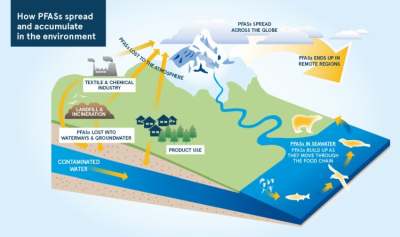Following calls from the scientific community and international campaigns by charities, many major supermarkets have been taking a precautionary approach and phasing out the use of any PFAS from their products, including school uniforms. However, analysis of the UK school uniforms market by Fidra reveals that many department stores, high street shops and independent retailers continue to sell school uniforms with PFAS stain resistance.
Fidra have joined the Swedish research consortia POPFREE, in an effort to find environmentally friendly alternatives to PFASs in consumer products.
Dr Christina Jönsson, POPFREE, coordinator explains ‘We know some PFASs are toxic but there have not been enough studies done on all the different chemicals being used, so we don’t know exactly how hazardous many of them are. But we know that once PFASs get into the environment they will spread, and stay around for hundreds of years, which is enough to warrant action as a precaution. We also need make sure that any PFAS replacement chemicals aren’t just as damaging.’
But before we all switch from PFAS to a new replacement, we need to know if stain resistance on uniforms is working in the real world. Perhaps stain resistance isn’t needed at all?
How useful is stain resistance?
Our survey examined the shopping and laundry habits of over 600 parents of primary-age children across the UK. Results revealed that stain resistance does not seem to reduce the frequency of washing or increase the life of a garment.
In fact, Fidra found that the parents who considered stain-resistant finishes important when buying uniforms washed trousers and skirts significantly more often (average 4.5 days between washes) than those who did not value stain resistance (average 5.4 days between washes). Similarly, Fidra found uniforms were being bought just as often whether stain resistance was valued by shoppers or not.
This may be partly due to the fact stain resistance doesn’t last. Often stain resistant finishes on uniforms are only guaranteed for around 20 washes. The stain-resistant coating, meanwhile, washes down the drain and into our environment.
Coatings often require specific care, such as tumble drying and no fabric softener to work effectively. Customers are unlikely to be treating their stain resisting items any differently from the rest of their laundry, so benefits from stain resistance will be lost.
There is no doubt that these PFAS-based coatings do have oil and water repelling abilities when first applied to the fabric – in fact, they are likely if anything to be overdesigned, providing protection at a level that some agree goes above and beyond the level required for school uniforms.
Supermarkets that have already made a change away from PFAS have been finding that non-PFAS stain resistant coatings, despite not repelling water and oil to the same degree a PFAS, are still satisfying customer needs just as well as their previous PFAS coatings.
We argue that instead of providing environmental benefits, these coatings are increasing the chemical burden on our environment, which will harm our ecosystems and could lead to consequences for our own human health.
What can shoppers do?
The good news is that since FIDRA started campaigning on this topic, things have improved.
Most high street clothes shops and supermarkets now provide non-PFAS stain resistant school clothing. And whilst the bulk of clothing does have stain resistance, especially school trousers, there are some products that don't.
Stain resistance is largely provided by two non-PFAS chemicals:
- Teflon EcoElite (TM) is described as a water-repellent, plant based, non-fluorinated fabric treatment.
- Bionic Finish Eco is described as a ‘[water-resistant], fluorine-free recipe
Note both these branded terms have PFAS versions and non-PFAS versions. Bionic Finish is PFAS based, but Bionic Finish Eco is not. Teflon is PFAS based, but Teflon Eco-Lite is not. Look for the 'eco' versions therefore, to avoid PFAS.
The FIDRA PFAS-free website includes a table by brand and what they offer (as of September 2022).
We discovered an independent website that sold school uniforms made from organic cotton with no added chemicals for stain resistance etc - EcoOutfitters
Buy secondhand
Of course, the most environmentally friendly option is still to use secondhand clothing. Many schools provide options for donating and purchasing school uniforms which are secondhand but in good condition. For un-branded items like skirts and trousers charity shops and pre-loved websites and apps are good options. The ethical clothing guide also features several pre-loved retailing options.





